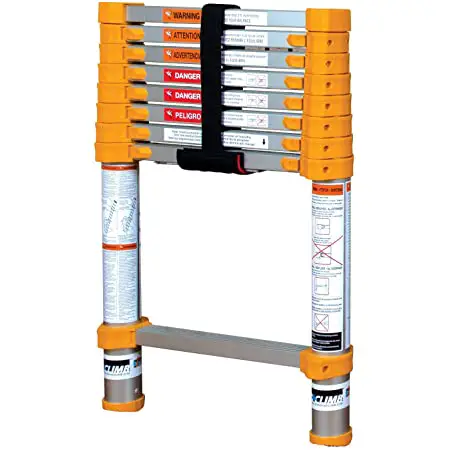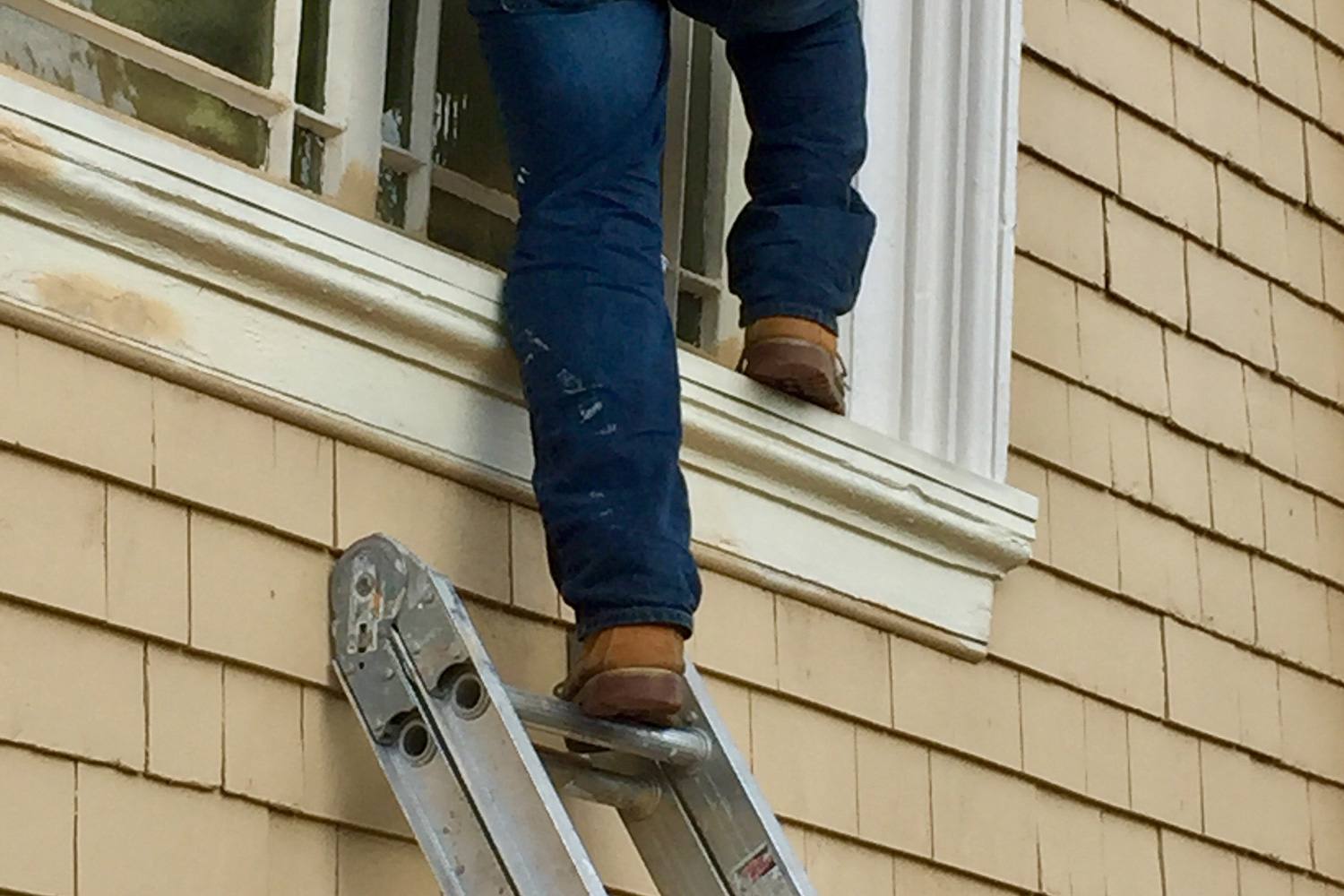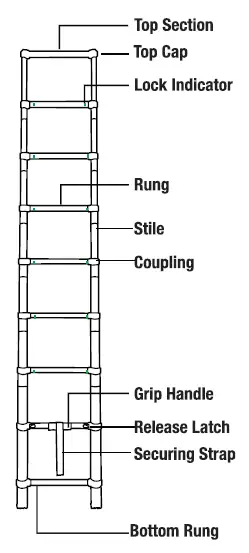XTEND CLIMB Home Series Telescoping Ladders

IMPORTANT: Refer to instruction manual. All instructions must be read carefully before using your XTEND+CLIMB.® telescopic ladder.
WARNING: FALLS FROM THE LADDER.FAILURE TO UNDERSTAND AND FOLLOW ALL SAFETY RULES AND OPERATIONAL INSTRUCTIONS COULD RESULT IN SERIOUS INJURY OR DEATH.
OPERATIONAL AND SAFETY INSTRUCTIONS
DANGER: FAILURE TO UNDERSTAND AND FOLLOW ALL SAFETY RULES AND OPERATIONAL INSTRUCTIONS COULD RESULT IN SERIOUS INJURY OR DEATHWARNING: ELECTRICITY HAZARD: Identify any electrical risks in the work area, such as overhead lines or other exposed electrical equipment and do not use the ladder where electrical risks occur.
COMPONENTS OF A TELESCOPIC LADDER
Top Section – Upper horizontal section of the ladder.Top Cap – Top section of the ladder that encloses the upper stile.Lock Indicator Window – on front of rung that displays green indicator that when the section is locked.Rung – Horizontal section used for climbing the ladder.Stile – Vertical member used to support the rungs and the ladder structure.Coupling – The section that connects the rung to the stile of the ladder.Grip Handle – Ergonomic pad on the bottom of the second rung from the bottom that the user uses to comfortably transport the ladder.Release Latch – Mechanical button that allows the user to unlock the telescoping ladder to start the closing process.Securing Strap – Nylon strap with hook and loop fasteners, which holds the ladder together during transportation and storage.Bottom Rung – Lower horizontal section used for climbing the ladder.MAX.LOAD:150KGS
WARNINGS:
- Inspect the ladder after delivery. Before every use visually check the ladder is not damaged and is safe to use. Do not use a damaged ladder.
- Do not use the ladder on a unlevel or unfirm base.
- Do not overreach.
- Do not erect ladder on contaminated ground.
- Do not ascend or descend unless you are facing the ladder.
- Do not carry equipment which is heavy or difficult to handle while using a ladder.
- Avoid work that imposes a sideways load on ladders, such as side-on drilling through solid materials.
- Warning, electricity hazard Identify any electrical risks in the work area, such as overhead lines or other exposed electrical equipment and do not use the ladder where electrical risks occur.
- Do not lean the ladder against unsuitable surfaces.
- Do not use the ladder if you are not fit enough.
- Certain medical conditions or medication, alcohol or drug abuse could make ladder use unsafe.
- Do not wear unsuitable footwear when climbing a ladder.
- Do not stand on the top three feet of a telescopic ladder.
- Do not bring your hands / fingers in rung area (area of shearing) when bringing the ladder in to its possible positions of use.
- Do not use the ladder as a bridge.
- Do not stand on the top three rungs of a leaning ladder. The user shall not climb beyond the 4th fully accessible rung from the top of a telescopic ladder when used in the leaning position.
- Do not climb ladder unless the indicator window shows the color green.
Valid Points:
- Maximum total load.
- Maximum number of users.
- Ladder can be used for domesticor non professional use.
- Ladder for can be used for professional Telescopic ladders in the leaning position with steps/rungs shall be used that the steps are in a horizontal position.
- Telescopic ladders in the leaning position with steps/rungs shall be used at the correct angle.
- Climbing side of ladder has release latches and lock indicator stickers.
- Only use the ladder in the direction as indicated, only if necessary due to design of ladder.
- Ladders used for access to a higher level shall be extended at least 1 meter above the landing point and secured, if necessary.
- Locking mechanisms for all extended rungs shall be checked & locked before use.
- Keep a secure grip on the ladder when ascending and descending. Maintain a handhold while working from a ladder or take additional safety precautions if you cannot.
- When rung is locked you will hear an audible click of the metal rods locking into place and see green in the window indicator window. All Locking devices shall be checked and be fully secured before every use.
OPERATIONAL AND SAFETY INSTRUCTIONS:
- Do Not Spend long periods on a ladder without regular breaks(tiredness is a risk).
- Use non-conductive ladders for unavoidable live electrical work.
- Do Not modify the ladder design.
- Do Not move a ladder while standing on it.
- For outdoor use caution to the wind.
- Ladder shall never be moved from the top.
- Prevent damage of the ladder when transporting e.g. by fastening and, ensure they are suitably placed to prevent damage.
- Ensure the ladder is suitable for the task
- Do not use the ladder if contaminated, e.g. with wet paint, mud, oil or snow.
- Do not use the ladder outside in adverse weather conditions, such as strong wind .
- For professional use a risk assessment shall be carried out respecting the legislation in the country of use.
- When positioning the ladder take into account risk of collision with the ladder e.g. from pedestrians, vehicles or doors. Secure doors (not fire exits) and windows where possible in the work area.
LADDER STORAGE:Important considerations when storing a ladder (not in use) should include the following:
- Store the ladder in a upright and closed postion.
- Store the ladder away from areas where its condition could deteriorate more rapidly (e.g. dampness, excessive heat, or exposed to the elements)?
- Store the ladder in a position which helps it to remain straight (e.g. hung by the stiles on proper ladder brackets or laid on a flat clutter free surface)?
- Store the ladder where it cannot be damaged by vehicles, heavy objects, or contaminants?
- Store the ladder where it cannot cause a trip hazard or an obstruction?
- Store the ladder securely where it cannot be easily used for criminal purposes?
- If the ladder is permanently positioned (e.g. on scaffolding), is it secured against unauthorized climbing (e.g. by children)
REPAIRS, MAINTENANCE AND STORAGE:
- Repairs and maintenance shall be carried out by a competent person and be in accordance with the producer’s instructions.
- NOTE: A competent person is someone who has the skills to carry out repairs or maintenance, (e.g. trained by the manufacturer.
- For repair and replacement of parts, (e.g. feet), if necessary contact the producer or distributor.
- Ladders should be stored in accordance with the producer’s instructions.
- Ladders made of or using thermoplastic, thermosetting plastic and reinforced plastic materials should be stored out of direct sunlight.
- Ladders made of wood should be stored in a dry place and shall not be coated with opaque and vapour-tight paints.
KEEP DOCUMENTS:
- Keep manual for future reference.
- Keep the original sales invoice in a safe, dry place for proof of purchase.
WARNING: AFTER DELIVERY AND BEFORE EVERY USE, A THOROUGH INSPECTION OF THE LADDER MUST BE MADE. IF ANY OF THE CHECKS CANNOT BE FULLY SATISFIED, DO NOT USE THE LADDER.
LADDER INSPECTION:
LIST OF ITEMS TO BE INSPECTED FOR REGULAR INSPECTION, THE F0LLOWING ITEMS SHALL BE TAKEN INTO ACCOUNT:
- Check that the stiles/legs (uprights) are not bent, bowed, twisted, dented, cracked, or corroded.
- Check that the stiles/legs around the fixing points for other components are in good condition and not dented cracked or corroded.
- Check that hardware / fixings (rivets, screws or bolts) are not missing, loose, or corroded.
- Check that rungs/steps/stabilizers are not missing, loose, excessively worn, corroded or damaged.
- Check that the hinges between front and rear sections are not damaged, loose or corroded.
- Check that the locking stays horizontal, back rails and corner braces are not missing, bent, loose, corroded or damaged.
- Check that the rung hooks are not missing, damaged, lose or corroded and engage properly on the rungs. (Do not use ladder if contaminated.)
- Check that guide brackets are not missing, damaged, loose or corroded and engage properly on the mating stile.
- Check that ladder feet/end caps are not missing, loose, excessively worn, corroded or damaged.
- Check that the entire ladder is free from contaminants ((e.g. dirt, mud, paint, oil, grease, wet paint or snow).
- Check that locking latches (if fitted) are not damaged or corroded and function correctly.
- Check that the platform (if fitted) has no missing parts or fixings and is not damaged or corroded.
- Check that stabilizers are not bent bowed twisted dented cracked or corrodedIf any of the above checks cannot be fully satisfied, you should NOT use the ladder. For special ladder types, further items identified by the manufacturer shall be taken into account.
Place the ladder on a sturdy level surface suitable on which to use a ladder. Release the strap that secures the ladder in its”storage configuration.” Place your foot on the bottom rung to hold the ladder in place. With both hands start to pull up on the rung that you determine will be the highest point to which you would like to extend the ladder. Extend each section until the steel locking pin engages. You will hear an audible click and see a green indicator on the rung below confirming that section is fully extended and locked. Continue extending the ladder all the way up. Once fully extended, each section should show a green lock indica tor. on each side of the rung . Visually inspect the ladder for any damage, debris and ensure that all open sections are locked.
EXTENDING THE LADDER (FULL WORKING HEIGHT)
Place the ladder on a sturdy level surface on which to use a ladder. Release the strap that secures the ladder in its”storage configuration. To Extend ladder, place your foot on the bottom rung to hold the ladder in place. With both hands start to pull up on the top rung. Extend each section until the steel locking pin engages. You will hear an audible click and see a green indicator on the rung below confirming that section is fully extended and locked. Continue extending the ladder all the way up until you have extended each section. Each rung should show a green lock indicator. Visually inspect the ladder for any damage, debris and that all open sections are locked.
CLOSING THE LADDERGreat care should be used when retracting the ladder. Do not place any part of your body including hands, fingers or thumbs, on, or between rungs or couplings above the closing rung. Ensure that you are on a sturdy level surface. Hold the ladder upright. Place thumbs on the highest release mechanism and push each thumb tab simultaneous towards the center of the rung and retract down each rung systematically to unsure safety gap on each rung is activated. Note: The Xtend+Climb® ladder utilizes a “soft close” system that ensures the rungs retract slowly. When fully retracted, attach the strap that secures the ladder around the top rung.
MAINTENANCE TIPS
WET LADDERIf the ladder is wet or if there is water on the laddero, pen the ladder to the maximum and,w ith a dry cloth, absorb the water. It is recommended to let the ladder dry fully opened,o n one side and then on the other,w ith the ladder leaning against a wall.
OXIDISED LADDERIf the ladder is oxidised (due to previous poor drying),t here will be white residue on the stiles.F irst, remove the spots with a dry cloth. Then, to ensure the ladder deploys and retracts correctly,u se a silicone based spray or a non-petroleum based furniture polish wipe once the ladder is fully opened and dry it correctly. Wait a few minutes and close the ladder. Never use a petroleum based product- it will damage the internal mechanism of your ladder.
PAINT OR OTHER SUBSTANCES STICKING TO STILESIf paint residues were left on the ladder,t hey must be removed using a sponge.D o not use steel wool since it might damage theopening/closing mechanism. After all residues have been removed from the stiles, apply a silicone based spray or a nonpetroleum based furniture polish wipe as indicated in above section“ Oxidised Ladder.’’
HARD TO MOVE LATCHESIf the latches are hard to push,u se a compressor or compressed air duster to properly clean the lacthes. Then perform maintainence on the latches (with a silicone based spray or a non-petroleum based furniture polish wipe) with ao rfward/backward movement. Dry excess spray with a dry cloth. DIFFICULTY IN OPENING OR CLOSING THE LADDERIf it becomes hard to open or close the ladder fully, extend the ladder, clean it, and maintain the stiles with a silicone based spray or a non-petroleum based furniture polish wipe. lithe rungs are jammed, use the spray on every stile and close the ladder for 15 to 20 minutes to let the lubricant penetrate the ladder. Then, open and close the ladder to ensure the spr ay reaches every area of the ladder.
DIFFICULTY IN OPENING OR CLOSING THE LADDERIf it becomes hard to open or close the ladder fully, extend the ladder, clean it, and maintain the stiles with a silicone based spray or a non-petroleum based furniture polish wipe. lithe rungs are jammed, use the spray on every stile and close the ladder for 15 to 20 minutes to let the lubricant penetrate the ladder. Then, open and close the ladder to ensure the spr ay reaches every area of the ladder.
WINTER CONDITIONSIf the opening/closing of the ladder is affected by winter conditions, open the ladder in a dry area until the stiles reach room temperature i.e. 18 to 21°C. Ensure there is no humidity left on the stiles and couplings. (if there is humidity or oxidation, please refer to section “Wet Ladder” or”Oxidised Ladder”). Finally, with the ladder opened, lubricate all the stiles.
MANUFACTURED BY
Core Distribution, Inc.113 Washington Ave NMpls., MN 55401(612) 330-9915www.xtendandclimb.com
[xyz-ips snippet=”download-snippet”]



